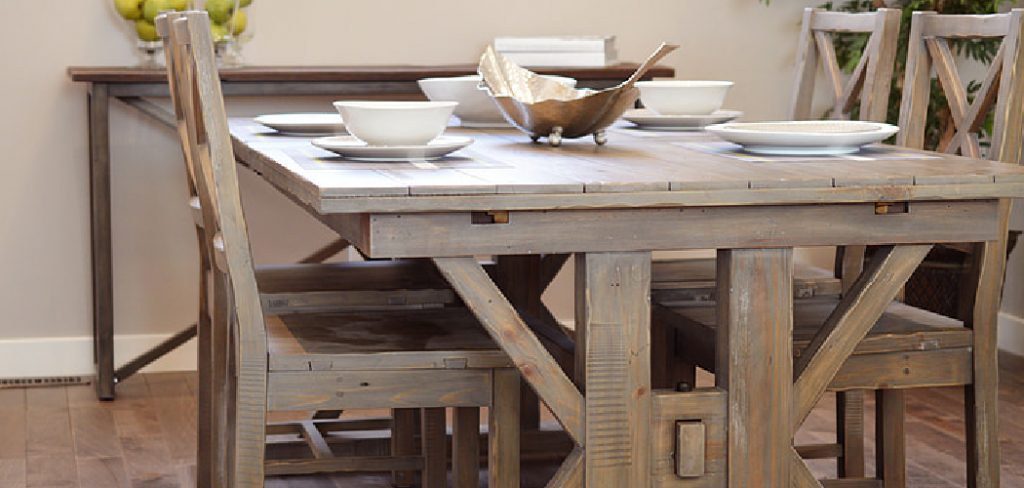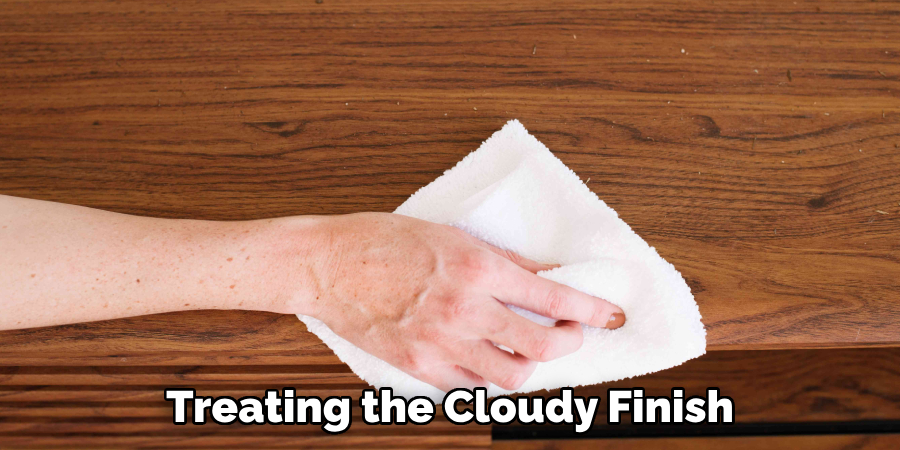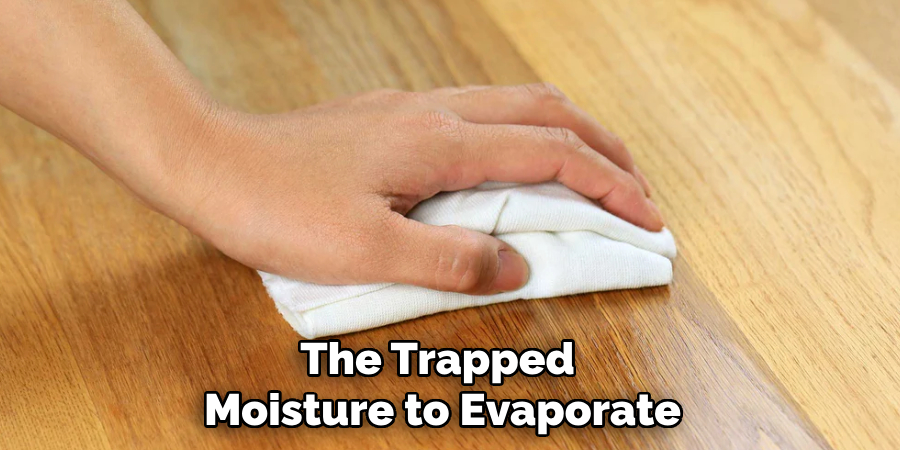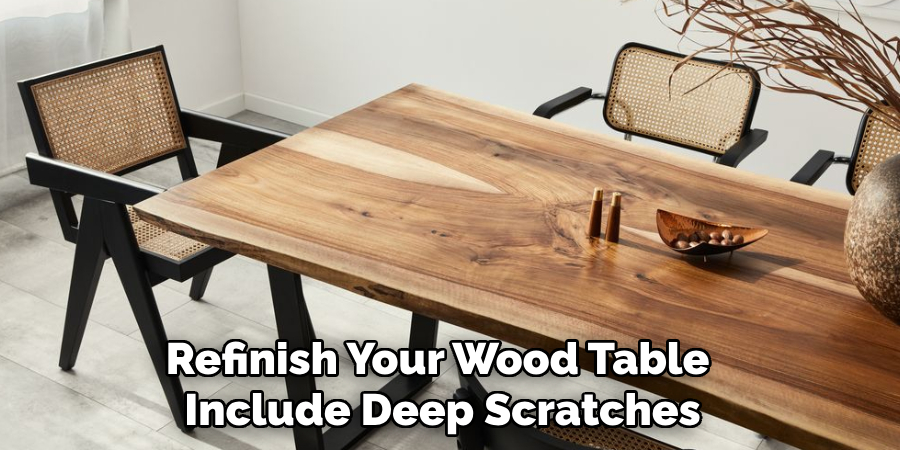A cloudy finish on a wood table can be an unsightly problem that diminishes the beauty and quality of your furniture. This issue often arises due to moisture trapped under the surface finish, commonly resulting from spills, humid conditions, or using the wrong cleaning products.

Fortunately, restoring your wood table to its original luster is possible with a few simple steps and the right materials. In this guide on how to fix cloudy finish on wood table, we’ll explore effective techniques and tips to clear up the cloudy finish and help you maintain the elegance of your wood table for years to come.
Why Does Wood Table Finish Get Cloudy?
Before we dive into the solutions, it’s essential to understand why wood table finish gets cloudy in the first place. There are a few reasons for this common issue:
Moisture:
Water or other liquids can seep through cracks or pores in the wood and get trapped under the surface finish, causing a cloudy appearance.
Humidity:
High levels of moisture in the air can also contribute to a cloudy finish by penetrating the wood and creating an environment for condensation.
Wrong Cleaning Products:
Using harsh chemicals or abrasive cleaners on your wood table can strip away the protective layer of finish, making it more susceptible to moisture damage and cloudiness.
8 Step-by-step Guidelines on How to Fix Cloudy Finish on Wood Table
Step 1: Identify the Affected Area
Before you begin treating the cloudy finish, it is crucial to pinpoint the specific areas on your wood table that need attention. Start by inspecting the entire surface under good lighting to identify spots or patches that appear dull or milky compared to the rest of the table. You might notice that the cloudiness is more prevalent in areas frequently exposed to spills or humidity, such as near seams or edges.
Gently run your hand over the surface to further discern any changes in texture or glossiness. Mark these areas with a small piece of tape or a sticky note to ensure you target them accurately during the restoration process. Identifying the affected area accurately is a key first step toward successfully restoring your table’s finish.

Step 2: Prepare the Surface
Once you have identified the affected areas on your wood table, the next step involves preparing the surface for treatment. Begin by thoroughly cleaning the table to remove any dirt, dust, or residual substances that might interfere with the process. Use a soft, lint-free cloth dampened with a mild soap solution or a high-quality wood cleaner.
Gently wipe the entire surface, focusing on the marked areas, and ensure that the wood is not saturated with excess liquid. After cleaning, use a dry cloth to wipe away any remaining moisture and allow the surface to air dry completely. Adequate preparation of the table surface ensures better adhesion and effectiveness of the upcoming restoration techniques, setting the stage for a successful repair.
Step 3: Try Spot Cleaning
In some cases, a cloudy finish might only be superficial and can quickly be resolved with spot cleaning. Use a clean cloth dampened with denatured alcohol or mineral spirits to gently rub the affected areas in a circular motion. These solvents work by breaking down any contaminants trapped under the finish, leaving behind a clear surface.
Remember not to use too much pressure as it can damage the wood’s surface or strip away more of the finish than necessary. After spot cleaning, wipe away any excess solvent and allow it to dry before moving on to the next step.
Step 4: Apply Heat
If spot cleaning didn’t do the trick, you might need to take a more targeted approach by applying heat directly to the affected areas. Using a hairdryer or heat gun on low heat, gently warm the cloudy spots while keeping a safe distance from the wood surface.
The heat will cause the trapped moisture to evaporate and escape through tiny cracks in the finish, resulting in a clear appearance. As you apply heat, keep an eye out for any changes in color or texture that might indicate overexposure or damage to the wood.

Step 5: Use White Vinegar
White vinegar is another effective natural remedy for clearing up cloudy finishes. Mix equal parts of white vinegar and water and use a soft cloth dampened with this solution to gently rub the affected areas. The acid in vinegar helps break down any oily substances or residue, leaving a clear and shiny surface.
After rubbing, use a clean cloth dipped in plain water to wipe away any remaining vinegar solution and dry thoroughly.
Step 6: Try Toothpaste
Believe it or not, toothpaste can also work wonders in restoring a cloudy finish on your wood table. Squeeze a small amount of non-gel toothpaste onto a soft cloth and gently rub it onto the affected areas using circular motions.
Toothpaste contains mild abrasives that can help remove stains and cloudiness without damaging the wood or finish. After rubbing for a few minutes, wipe off the excess toothpaste with a clean, damp cloth and dry thoroughly.
Step 7: Sand and Refinish
If the above methods do not yield satisfactory results, you might need to sand down the affected areas and refinish them entirely. Using fine-grit sandpaper, gently sand away the top layer of finish to remove any trapped moisture or residue.
Once sanded, use a wood stain to match the rest of your table’s finish and apply multiple coats of clear polyurethane for protection. Allow each coat to dry completely before adding the next one for a smooth and glossy final result.
Step 8: Prevent Future Cloudiness
To keep your wood table looking its best, it is essential to take preventive measures to avoid future cloudiness. Use coasters and tablecloths to protect the surface from spills and moisture, and regularly clean and polish with appropriate wood products.
Avoid using harsh chemicals or abrasive cleaners, and consider adding a layer of wax or polish for extra protection. With proper care, your wood table’s finish will stay clear and shiny for years to come.

Additional Tips
Regular Maintenance:
Schedule routine inspections and cleanings for your wood furniture to catch and address any early signs of cloudiness or damage before they become problematic.
Humidity Control:
Keep your indoor climate consistent to prevent excess moisture that can seep into the wood. Use a dehumidifier in rooms where high humidity is a concern.
Sunlight Exposure:
Avoid placing wooden tables in direct sunlight for prolonged periods, as UV rays can fade finishes and increase susceptibility to cloudiness or other types of damage.
Immediate Spill Cleanup:
Quickly clean up any spills to prevent liquids from seeping into the wood. Blot gently with a soft cloth or sponge without rubbing vigorously.
Using Pads and Liners:
In addition to coasters, use felt pads under heavy objects and soft liners for drawers to reduce the risk of marks and scratches.
By incorporating these practices on how to fix cloudy finish on wood table, you can enjoy your wood table’s beauty and functionality while minimizing the risk of cloudiness and prolonging its life.
Frequently Asked Questions
Q: How Do I Prevent My Wood Table’s Finish From Becoming Cloudy in the Future?
A: To avoid future cloudiness, use coasters and tablecloths to protect the surface from spills and moisture. Regularly clean and polish with appropriate wood products and avoid using harsh chemicals or abrasive cleaners. Consider adding a layer of wax or polish for extra protection.
Q: Can I Use Any Type of Toothpaste for Restoring a Cloudy Finish on My Wood Table?
A: It is best to use non-gel toothpaste with mild abrasives for this purpose. Avoid using whitening or gel toothpaste, as they can be harsh and may damage the wood surface.
Q: Is It Safe to Use Heat on My Wood Table’s Finish?
A: Yes, it is safe to use low heat from a hairdryer or heat gun on cloudy areas. However, be sure to keep a safe distance from the wood surface and monitor any color or texture changes that may indicate damage.
Q: How Do I Know If It’s Time to Refinish My Wood Table?
A: Signs that it may be time to refinish your wood table include deep scratches, significant discoloration or fading, and an overall dull appearance. If spot cleaning and heat methods do not work, refinishing may be necessary.

Conclusion
Restoring a cloudy finish on your wood table doesn’t have to be a daunting task. By following the step-by-step methods outlined in this guide on how to fix cloudy finish on wood table, you can bring back the natural beauty and luster of your furniture. Whether you choose spot cleaning, heat application, or even a full refinish, each technique offers a viable solution to clear up foggy finishes and revitalize the surface.
Moreover, adopting preventive maintenance strategies will ensure your wood table remains pristine, enhancing its longevity and the aesthetic appeal of your home. With patience and careful attention, your wood table can continue to be a cherished centerpiece for many years.
